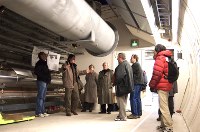 |
 |
|||||||||||||
|
|||||||||||||
|
|||||||||||||
|
The small town of Schenefeld just outside Hamburg in northern Germany isn't exactly known for its sights or its tourism. Many Schenefeld citizens, however, have recently become tourists in their own neighbourhood: ever since the construction works for the European XFEL started on 8 January, the building site sees a steady flow of visitors stopping by on or from their way to the shops, checking on progress, curious about their new neighbour. While the whole ILC project can learn a lot from this curiosity (namely establishing good contact with neighbours when construction for the collider starts), one specific group is digging deeper: the 'conventional facilities and siting (CF&S)' team is establishing close contacts to experts working on the European XFEL to learn from them and to help when possible.
“We want to understand the design process that led to the XFEL design and get a rock-solid foundation for our engineering from an existing large-scale project,” CF&S expert Vic Kuchler from Fermilab said at a meeting in December, where the ILC CF&S group travelled to DESY to meet the XFEL team and visit already set up infrastructure. The European X-Ray Free-Electron Laser will stretch underground for three and a half kilometres, running from DESY to the future research campus in Schenefeld. There are many similarities between the projects, mainly since the accelerator technology of both ILC and XFEL has the same root, namely the TESLA technology. These similarities also extend into the field of CF&S. “Obviously it is almost impossible to develop a facility design without a specific site,” concedes Marc Ross, ILC Project Manager, “but we can look into the technical solutions of current other projects and assess to which extent their approaches could match the ILC needs.” These assessments must be based on hard data, and that's exactly what the CF&S team is currently working on. In the two meetings where ILC and XFEL experts have come together so far, the ILC team received detailed insights to the concepts and designs for the European XFEL, while the XFEL colleagues received thought-provoking questions and comments. The two projects are on rather different timescales: while R&D for the ILC is still in full swing, the free-electron laser has just entered the construction phase. The XFEL's agenda for the coming years therefore lists achieving high-yield industrial serial production in all technology fields and eventually the successful integration of all subsystems into a working facility (the machine is supposed to start running in 2014). Many new technological problems will need to be solved. One essential prerequisite is a functioning and strong international collaboration. “It is maybe this collaborative effort, with forces widely spread, which is the hardest to master now. We need adopted processes and management structures and they do not exist yet in all details. However, it is exciting to form them and I am convinced following this closely is also of paramount importance for ILC,” says Thomas Hott from DESY, XFEL Technical Coordinator. He sees the close professional and personal contacts as key for future exchange of ideas and knowledge between the two projects. “There is a lot of overlap between ILC and XFEL work in many labs already, and there is a lot of information, and maybe even advice, worth to be exchanged in both directions and in all project fields.” From in between construction sites and lorry loads of soil, the European-XFEL colleagues say that they would be pleased to return the favour of a fresh eye that they received from the ILC CF&S team. “We could listen to their concepts for the ILC,” offers Thomas Hott, “to give them our feedback and to share a few lessons that we have learnt.” “I will look forward to our continued interactions and discussion,” smiles Vic Kuchler. -- Barbara Warmbein |
|||||||||||||
| © International Linear Collider |
